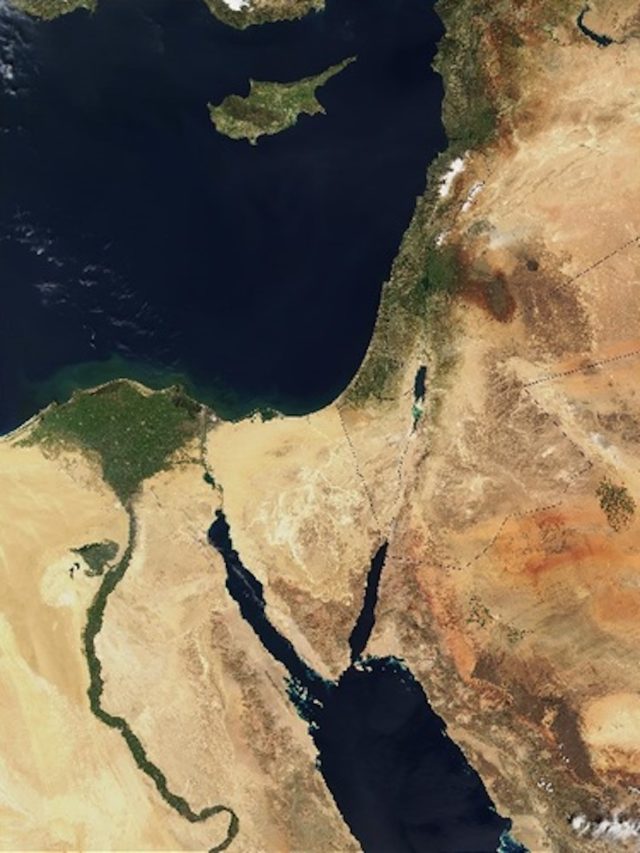Israel’s Prime Minister Naftali Bennett went to Sharm el-Sheikh to meet Egyptian President Abdul Fattah al-Sisi and Crown Prince of Abu Dhabi Mohammed bin Zayed Al Nahyan (MBZ). In an open sign of displeasure with the Biden administration, they were clear about their purpose: “shared security interests, of which there are quite a few, in all their aspects,” said one diplomat. A new regional architecture, centered on opposing Iran, appears to be emerging.
History first: for centuries, Great Britain was the guarantor of freedom of the seas and security in the Middle East. After World War II and into the mid-1950s, as Britain divested itself of its colonies and responsibilities, the United States took over. It was a major realignment that had both promise and problems.
The Eisenhower administration’s priority was to keep the Arabs on “our side” of the Cold War. They created the theoretical “Northern Tier” of Turkey, Iran, Pakistan, and Afghanistan on Russia’s borders, and planned to bring Iraq, Syria, Jordan, and Egypt in as players. Egypt declined — so the U.S. sought to bribe Nasser by helping to push the British out of the Suez Canal Zone and “solving” the Arab-Israel crisis by leaning on Israel. “What we had in mind was (a) slightly smaller Israel,” said one American diplomat. During the 1956 Suez war, Eisenhower went further. When Nasser cut off Britain’s oil supply, Eisenhower refused to provide North American oil, telling aides, “Those who began this operation should be left to work out their own oil problems — to boil in their own oil, so to speak.”
Missing from the American construct was the understanding that Egypt’s priority was not to involve itself in the Cold War and not to join any of the regional compacts, but to be the leader of the Sunni Arab world. (Read the brilliant Ike’s Gamble by Michael Doran for details.)
Now, in 2022, the Biden administration, like its earlier counterpart, appears to have priorities and goals in the Middle East. And like its earlier counterpart, they appear detached from the priorities of some of America’s traditional allies in the region. A new alignment of countries appears to be emerging — not only without the United States but irritated by the United States.
The Abraham Accords are the realization by certain of the Gulf States that their security, their economies, and their people would be enhanced by a relationship with Israel. Those countries — plus Morocco and Sudan — were willing to readjust broad priorities to meet current conditions. The Palestinians would no longer be the focus of their attention; but rather Iran in both its nuclear and conventional aspects. Pacts with the regional military power most closely aligned with their interests were essential — that was Israel. The arrangement was ginned up, fostered, and blessed by the previous American administration.
The current administration is less enthusiastic. Its priorities appear to be related to improving American relations with the Islamic Republic of Iran.
- Bringing/bribing Iran into a nuclear deal would have the U.S. lift sanctions and allow Tehran to sell as much oil as it chooses. The money will enable Iran to pursue both its nuclear project and support for Hamas, Hezb’allah, the Houthis, and various radical Shiite groups in Iraq and across Africa.
- This means backing away from traditional American Sunni Arab allies, including Saudi Arabia, Egypt, the United Arab Emirates, and Bahrain. In particular, the freezing of arms sales to Saudi Arabia constitutes a bribe for Iran.
- Backing away from Israel by restoring focus to the “two-state solution” resulting in an independent Palestinian state is also a bribe for Iran.
This goes along with decreasing American oil and gas production even in the face of rising prices and inflation, looking for substitutes in Venezuela and Iran, and stifling the emergence of a gas pipeline from the eastern Mediterranean to Europe. It is notable but not surprising that President Joe Biden called to ask the UAE and Saudi Arabia to increase production. Both declined.
Regional parties, including Israel, often see threats differently than the United States. It stands to reason — they’re closer to the mess. Because they are, Israel’s entry into CENTCOM and the military exercise recently concluded in the Red Sea, holds a bit of promise that the U.S. may not be altogether out of the game. Outgoing CENTCOM commander, Gen. Frank McKenzie, told Congress: “CENTCOM is focused on operationalizing the Abraham Accords, as we brought Israel into our area of operations, and missile defense is one area of cooperation that all our partners understand… it’s particularly important when you consider the threat that Iranian missiles pose.”
However, the general also said he was worried about Israel and Iran attacking one another, “because many times our forces are at risk,” according to Al-Arabiya and reported in the Jerusalem Post. “I think it’s obvious that Israel is going to take steps to defend itself when it’s confronted with Iranian actions. And of course, Iran is dedicated to the destruction of Israel.”
Excuse us, Gen. McKenzie — Iran is dedicated to the destruction of Israel and the Sunni Gulf states, the influence of Egypt, control of both the Persian Gulf and the Red Sea, and the presence of the United States in the region. Our forces are at risk simply by being.
The new Arab-Israeli regional architecture recognizes that. The United States government must recognize and act on it as well.






